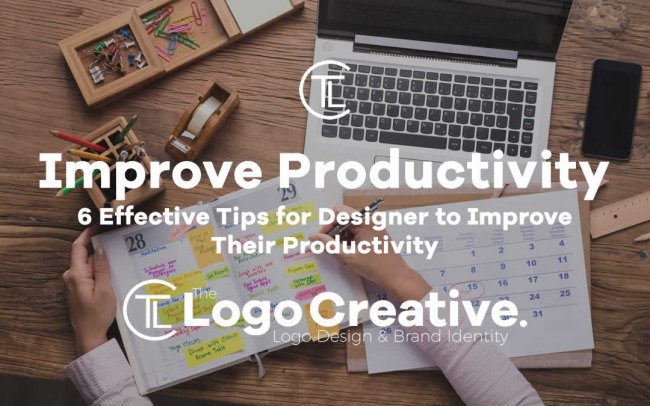Here are some tried and tested productivity tips for designers.
You as a designer are working in the industry being characterized by creativity and deadlines. This profession requires you to come up with a lot of brainstorming, creativity, and uniqueness to stay competitive.
Apart from that, you need to make sure that the core elements of a project like testing, concepts, design and further advancement must be done precisely and timely. A multitude of other processes sprouting from the main task may be the last thing you worry about. It becomes difficult for the designer to strike a balance between his main “job” and other mundane things. Such hassles make it difficult for the designers to stay on the top of the project—even leading to their burnout. Don’t worry! Here are some productivity tips for web designers to stay focused and creative as well.

Table of Contents
Write Down Your Ideas:
“Write down the thoughts of the moment. Those that come unsought for are commonly the most valuable.” Francis Bacon, Sr.
No matter if you hit upon the idea in words or images, make sure to write them down. Here I have provided some convincing reasons why you should develop this habit.
- Wonderful ideas can pop up at odd times but they tend to not stay for long in your head. Writing them immediately helps you capture them fast before they get vanished in the wind.
- Another reason is that you can stick to your original idea when your mind gets confused with so many ideas. It helps you find a direction.
- You never know a rough sketch on paper can lead you to awesome design.
Therefore, keep a pocket-size notebook or sketchbook handy with you all times.
Break Down Big Tasks:
From working with a developer, making tweaks, to brainstorming over a new project, a designer can be snowed under with a lot of tasks on any given day. What if you have to deal with multiple stakeholders or cross-functional teams?
Breaking down the tasks into manageable milestones is an answer. For example, define each part or goal of the design and divide it accordingly. Ponder over the priorities. Give yourself time and don’t allocate too many tasks at a time. This way, you can organize your overwhelming tasks and keep the things in your control.
Learn How To Handle The Clients:
The relationship between a web designer and a non-technical client is not easy. They often struggle with communication. Sometimes a client is not familiar with the jargons like wireframes, vector graphic and mock up. Sometimes the designers are not able to fulfill what exactly a client wants from the design. Communicating effectively with clients is a vital component of being a good designer.
Here’s how you can develop a sense of how best to interact with each client.
- Understand their business.
- Don’t use industry-specific language. Try to pick up on their terminology. Or you may explain to them some of the terms.
- Show them visually how things work.
- Ask questions to clarify the things.
Setting up an effective and clear communication with the clients helps you achieve the goals and live up to their expectations as well.
Learn The Shortcuts:
There is no shortcut to success. But sometimes shortcuts are useful, especially when you don’t want to go through a lengthy menu for basic features. I am talking about keyword shortcuts that save you time and increase your productivity as well. Plus, it helps you work smarter. For example, Command-Tab can be used to run apps on your Mac or screenshot of the entire screen can be taken using Command+Shift+3. Such shortcuts are really a lifesaver when you are working over a complicated tool like Adobe Photoshop, InVision, and Affinity.
Give Yourself A Break:
Continuously working for 8-10 hours sitting in front of a PC screen every day makes your brain feel saturated. It hampers your creativity which in turn hinders your productivity.
According to one study,the brain gradually stops responding if certain activity remains constant over time. Consequently, you end up losing your focus. The study further suggests that brief mental breaks can help stay focused and improve the creative approach.
This is why you should take a break during your day. Even five minutes to have a coffee, go for a walk or read the book will help you get your brain on the right mode. You come back to your work focused and refreshed as well.
Choose The Right Tools:
Work smart, not hard. Whether you are designing a website, mobile app or an infographic, make sure to have tech-savvy tools in place. Keep in mind that being a good designer is not just about possessing creativity and implication but also having the right software.
Nowadays, there are many sophisticated tools that can increase your overall working productivity. Here are a few of them.
- ProofHub is a proofing tool that will help you imply the changes required by the client.
- Canva to find the right color combination for your designs
- Illustrator helps you create icons, logo and sketch effortlessly.
- SavahApp is a prototyping tool to check the look, feel and responsiveness of your design before the actual process.
Bottom Line:
No matter if you are an in-house designer, a freelancer or a business owner, you should deliver the project timely, efficiently. And it takes you to be productive and creative as well to make it happen. The above tips will make it easier for you to keep your task on track while increasing your productivity. What do you think? Share your views on this source of information by commenting below.
Author Bio
Athar is a co-founder of Savah App, a product that helps teams with an all-in-one platform for prototyping, design collaboration, and workflow.

